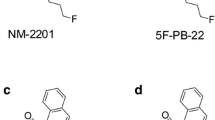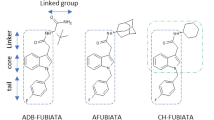Abstract
Whereas non-fluoropentylindole/indazole synthetic cannabinoids appear to be metabolized preferably at the pentyl chain though without clear preference for one specific position, their 5-fluoro analogs’ major metabolites usually are 5-hydroxypentyl and pentanoic acid metabolites. We determined metabolic stability and metabolites of N-(1-amino-3-methyl-1-oxobutan-2-yl)-1-pentyl-1H-indazole-3-carboxamide (AB-PINACA) and 5-fluoro-AB-PINACA (5F-AB-PINACA), two new synthetic cannabinoids, and investigated if results were similar. In silico prediction was performed with MetaSite (Molecular Discovery). For metabolic stability, 1 μmol/L of each compound was incubated with human liver microsomes for up to 1 h, and for metabolite profiling, 10 μmol/L was incubated with pooled human hepatocytes for up to 3 h. Also, authentic urine specimens from AB-PINACA cases were hydrolyzed and extracted. All samples were analyzed by liquid chromatography high-resolution mass spectrometry on a TripleTOF 5600+ (AB SCIEX) with gradient elution (0.1% formic acid in water and acetonitrile). High-resolution full-scan mass spectrometry (MS) and information-dependent acquisition MS/MS data were analyzed with MetabolitePilot (AB SCIEX) using different data processing algorithms. Both drugs had intermediate clearance. We identified 23 AB-PINACA metabolites, generated by carboxamide hydrolysis, hydroxylation, ketone formation, carboxylation, epoxide formation with subsequent hydrolysis, or reaction combinations. We identified 18 5F-AB-PINACA metabolites, generated by the same biotransformations and oxidative defluorination producing 5-hydroxypentyl and pentanoic acid metabolites shared with AB-PINACA. Authentic urine specimens documented presence of these metabolites. AB-PINACA and 5F-AB-PINACA produced suggested metabolite patterns. AB-PINACA was predominantly hydrolyzed to AB-PINACA carboxylic acid, carbonyl-AB-PINACA, and hydroxypentyl AB-PINACA, likely in 4-position. The most intense 5F-AB-PINACA metabolites were AB-PINACA pentanoic acid and 5-hydroxypentyl-AB-PINACA.







Similar content being viewed by others
Abbreviations
- AB-PINACA:
-
N-(1-amino-3-methyl-1-oxobutan-2-yl)-1-pentyl-1H-indazole-3-carboxamide
- CB:
-
Cannabinoid
- CL:
-
Clearance
- cps:
-
Counts per second
- CYP:
-
Cytochrome P450
- ER:
-
Extraction ratio
- ESI:
-
Electrospray ionization
- FDA:
-
Food and Drug Administration
- HLM:
-
Human liver microsomes
- HRMS:
-
High-resolution mass spectrometry
- IDA:
-
Information-dependent acquisition
- LC-MS:
-
Liquid chromatography-mass spectrometry
- MDF:
-
Mass defect filter
- MS:
-
Mass spectrometry
- MW:
-
Molecular weight
- NADPH:
-
Nicotinamide adenine dinucleotide phosphate reduced form
- NPS:
-
Novel psychoactive substances
- Q:
-
Qualifier
- Q-TOF:
-
Quadrupole/time of flight
- T:
-
Target
- TOF:
-
Time of flight
REFERENCES
European Monitoring Centre for Drugs and Drug Addiction. Perspectives on drugs: synthetic cannabinoids in Europe. 2014.
American Association of Poison Control Centers. Synthetic marijuana data, updated January 31, 2015. https://aapcc.s3.amazonaws.com/files/library/Syn_Marijuana_Web_Data_through_1.2015.pdf
Gurney SMR, Scott KS, Kacinko SL, Presley BC, Logan BK. Pharmacology, toxicology, and adverse effects of synthetic cannabinoid drugs. Forensic Sci Rev. 2013;26:53–77.
ElSohly MA, Gul W, Wanas AS, Radwan MM. Synthetic cannabinoids: analysis and metabolites. Life Sci. 2014;97(1):78–90.
Chimalakonda KC, Seely KA, Bratton SM, Brents LK, Moran CL, Endres GW, et al. Cytochrome P450-mediated oxidative metabolism of abused synthetic cannabinoids found in K2/Spice: identification of novel cannabinoid receptor ligands. Drug Metab Dispos. 2012;40(11):2174–84.
De Brabanter N, Esposito S, Geldof L, Lootens L, Meuleman P, Leroux-Roels G, et al. In vitro and in vivo metabolisms of 1-pentyl-3-(4-methyl-1-naphthoyl)indole (JWH-122). Forensic Toxicol. 2013;31(2):212–22.
De Brabanter N, Esposito S, Tudela E, Lootens L, Meuleman P, Leroux-Roels G, et al. In vivo and in vitro metabolism of the synthetic cannabinoid JWH-200. Rapid Commun Mass Spectrom. 2013;27(18):2115–26.
Gandhi A, Zhu M, Pang S, Wohlfarth A, Scheidweiler K, Liu H-f, et al. First characterization of AKB-48 metabolism, a novel synthetic cannabinoid, using human hepatocytes and high-resolution mass spectrometry. AAPS J. 2013;15(4):1091–9.
Gandhi AS, Wohlfarth A, Zhu M, Pang S, Castaneto M, Scheidweiler KB, et al. High-resolution mass spectrometric metabolite profiling of a novel synthetic designer drug, N-(adamantan-1-yl)-1-(5-fluoropentyl)-1H-indole-3-carboxamide (STS-135), using cryopreserved human hepatocytes and assessment of metabolic stability with human liver microsomes. Drug Test Anal. 2014. doi:10.1002/dta.1662.
Gandhi AS, Zhu M, Pang S, Wohlfarth A, Scheidweiler KB, Huestis MA. Metabolite profiling of RCS-4, a novel synthetic cannabinoid designer drug, using human hepatocyte metabolism and time of flight mass spectrometry. Bioanalysis. 2014;6(11):1471–85.
Grigoryev A, Kavanagh P, Melnik A. The detection of the urinary metabolites of 1-[(5-fluoropentyl)-1H-indol-3-yl]-(2-iodophenyl)methanone (AM-694), a high affinity cannabimimetic, by gas chromatography-mass spectrometry. Drug Test Anal. 2013;5(2):110–5.
Grigoryev A, Kavanagh P, Melnik A. The detection of the urinary metabolites of 3-[(adamantan-1-yl)carbonyl]-1-pentylindole (AB-001), a novel cannabimimetic, by gas chromatography-mass spectrometry. Drug Test Anal. 2012;4(6):519–24.
Grigoryev A, Melnik A, Savchuk S, Simonov A, Rozhanets V. Gas and liquid chromatography-mass spectrometry studies on the metabolism of the synthetic phenylacetylindole cannabimimetic JWH-250, the psychoactive component of smoking mixtures. J Chromatogr B Analyt Technol Biomed Life Sci. 2011;879(25):2519–26.
Grigoryev A, Savchuk S, Melnik A, Moskaleva N, Dzhurko J, Ershov M, et al. Chromatography-mass spectrometry studies on the metabolism of synthetic cannabinoids JWH-018 and JWH-073, psychoactive components of smoking mixtures. J Chromatogr B Analyt Technol Biomed Life Sci. 2011;879(15–16):1126–36.
Hutter M, Broecker S, Kneisel S, Auwärter V. Identification of the major urinary metabolites in man of seven synthetic cannabinoids of the aminoalkylindole type present as adulterants in ‘herbal mixtures’ using LC-MS/MS techniques. J Mass Spectrom. 2012;47(1):54–65.
Hutter M, Moosmann B, Kneisel S, Auwärter V. Characteristics of the designer drug and synthetic cannabinoid receptor agonist AM-2201 regarding its chemistry and metabolism. J Mass Spectrom. 2013;48(7):885–94.
Kavanagh P, Grigoryev A, Melnik A, Simonov A. The identification of the urinary metabolites of 3-(4-methoxybenzoyl)-1-pentylindole (RCS-4), a novel cannabimimetic, by gas chromatography-mass spectrometry. J Anal Toxicol. 2012;36(5):303–11.
Sobolevsky T, Prasolov I, Rodchenkov G. Detection of urinary metabolites of AM-2201 and UR-144, two novel synthetic cannabinoids. Drug Test Anal. 2012;4(10):745–53.
Wohlfarth A, Gandhi A, Pang S, Zhu M, Scheidweiler K, Huestis M. Metabolism of synthetic cannabinoids PB-22 and its 5-fluoro analog, 5F-PB-22, by human hepatocyte incubation and high-resolution mass spectrometry. Anal Bioanal Chem. 2014;406(6):1763–80.
Wohlfarth A, Pang S, Zhu M, Gandhi AS, Scheidweiler KB, Huestis MA. Metabolism of RCS-8, a synthetic cannabinoid with cyclohexyl structure, in human hepatocytes by high-resolution MS. Bioanalysis. 2014;6(9):1187–200.
Wohlfarth A, Pang S, Zhu M, Gandhi AS, Scheidweiler KB, Liu H-F, et al. First metabolic profile of XLR-11, a novel synthetic cannabinoid, obtained by using human hepatocytes and high-resolution mass spectrometry. Clin Chem. 2013;59(11):1638–48.
Zhang Q, Ma P, Cole R, Wang G. Identification of in vitro metabolites of JWH-015, an aminoalkylindole agonist for the peripheral cannabinoid receptor (CB2) by HPLC-MS/MS. Anal Bioanal Chem. 2006;386(5):1345–55.
Makriyannis A, Deng H. Cannabimimetic indole derivatives, patent WO/2001/028557. 2001.
Uchiyama N, Matsuda S, Wakana D, Kikura-Hanajiri R, Goda Y. New cannabimimetic indazole derivatives, N-(1-amino-3-methyl-1-oxobutan-2-yl)-1-pentyl-1H-indazole-3-carboxamide (AB-PINACA) and N-(1-amino-3-methyl-1-oxobutan-2-yl)-1-(4-fluorobenzyl)-1H-indazole-3-carboxamide (AB-FUBINACA) identified as designer drugs in illegal products. Forensic Toxicol. 2013;31(1):93–100.
European Monitoring Centre for Drugs and Drug Addiction. EMCDDA—Europol 2013 annual report on the implementation of Council Decision 2005/387/JHA2014.
Pfizer Inc. Indazole derivatives, patent WO/2009/106982. 2009.
Drug Enforcement Administration. Schedules of controlled substances: temporary placement of three synthetic cannabinoids into schedule I (AB-CHMINACA, AB-PINACA, THJ-2201). Fed Register. 2014;79(244):75767–71.
Takayama T, Suzuki M, Todoroki K, Inoue K, Min JZ, Kikura-Hanajiri R, et al. UPLC/ESI-MS/MS-based determination of metabolism of several new illicit drugs, ADB-FUBINACA, AB-FUBINACA, AB-PINACA, QUPIC, 5F-QUPIC and α-PVT, by human liver microsome. Biomed Chromatogr. 2014;28(6):831–8.
Thomsen R, Nielsen LM, Holm NB, Rasmussen HB, Linnet K, the IC. Synthetic cannabimimetic agents metabolized by carboxylesterases. Drug Test Anal. 2014. doi:10.1002/dta.173.
Baranczewski P, Stanczak A, Sundberg K, Svensson R, Wallin A, Jansson J, et al. Introduction to in vitro estimation of metabolic stability and drug interactions of new chemical entities in drug discovery and development. Pharmacol Rep. 2006;58(4):453–72.
McNaney CA, Drexler DM, Hnatyshyn SY, Zvyaga TA, Knipe JO, Belcastro JV, et al. An automated liquid chromatography-mass spectrometry process to determine metabolic stability half-life and intrinsic clearance of drug candidates by substrate depletion. Assay Drug Dev Technol. 2008;6(1):121–9.
Lavé T, Dupin S, Schmitt C, Valles B, Ubeaud G, Chou RC, et al. The use of human hepatocytes to select compounds based on their expected hepatic extraction ratios in humans. Pharm Res. 1997;14(2):152–5.
Bolze S, Lacombe O, Durand G, Chaimbault P, Massiere F, Gay-Feutry C, et al. Standardization of a LC/MS/MS method for the determination of acyl glucuronides and their isomers. Curr Sep. 2002;20(2):55–9.
Shipkova M, Armstrong VW, Oellerich M, Wieland E. Acyl glucuronide drug metabolites: toxicological and analytical implications. Ther Drug Monit. 2003;25(1):1–16.
Horng H, Benet LZ. The nonenzymatic reactivity of the acyl-linked metabolites of Mefenamic acid toward amino and thiol functional group bionucleophiles. Drug Metab Dispos. 2013;41(11):1923–33.
Park BK, Kitteringham NR. Effects of fluorine substitution on drug metabolism: pharmacological and toxicological implications. Drug Metab Rev. 1994;26(3):605–43.
ACKNOWLEDGMENTS
This research was supported by the Intramural Research Program of the National Institute on Drug Abuse, National Institutes of Health. AB-PINACA and 5F-AB-PINACA were generously donated by the Drug Enforcement Administration. Molecular Discovery kindly provided the MetaSite software.
Conflict of Interest
None
Author information
Authors and Affiliations
Corresponding author
Electronic Supplementary Material
Below is the link to the electronic supplementary material.
Supplementary Fig. A
Proposed human hepatic metabolic pathway of AB-PINACA; ambiguous assignments of functional groups are shown as Markush structures (JPEG 449 kb)
Supplementary Fig. B
Proposed human hepatic metabolic pathway of 5F-AB-PINACA; ambiguous assignments of functional groups are shown as Markush structures (JPEG 424 kb)
Supplementary Table 1
(DOCX 48.5 kb)
Supplementary Table 2
(DOCX 49 kb)
Supplementary Table 3
(DOCX 13 kb)
Rights and permissions
About this article
Cite this article
Wohlfarth, A., Castaneto, M.S., Zhu, M. et al. Pentylindole/Pentylindazole Synthetic Cannabinoids and Their 5-Fluoro Analogs Produce Different Primary Metabolites: Metabolite Profiling for AB-PINACA and 5F-AB-PINACA. AAPS J 17, 660–677 (2015). https://doi.org/10.1208/s12248-015-9721-0
Received:
Accepted:
Published:
Issue Date:
DOI: https://doi.org/10.1208/s12248-015-9721-0




